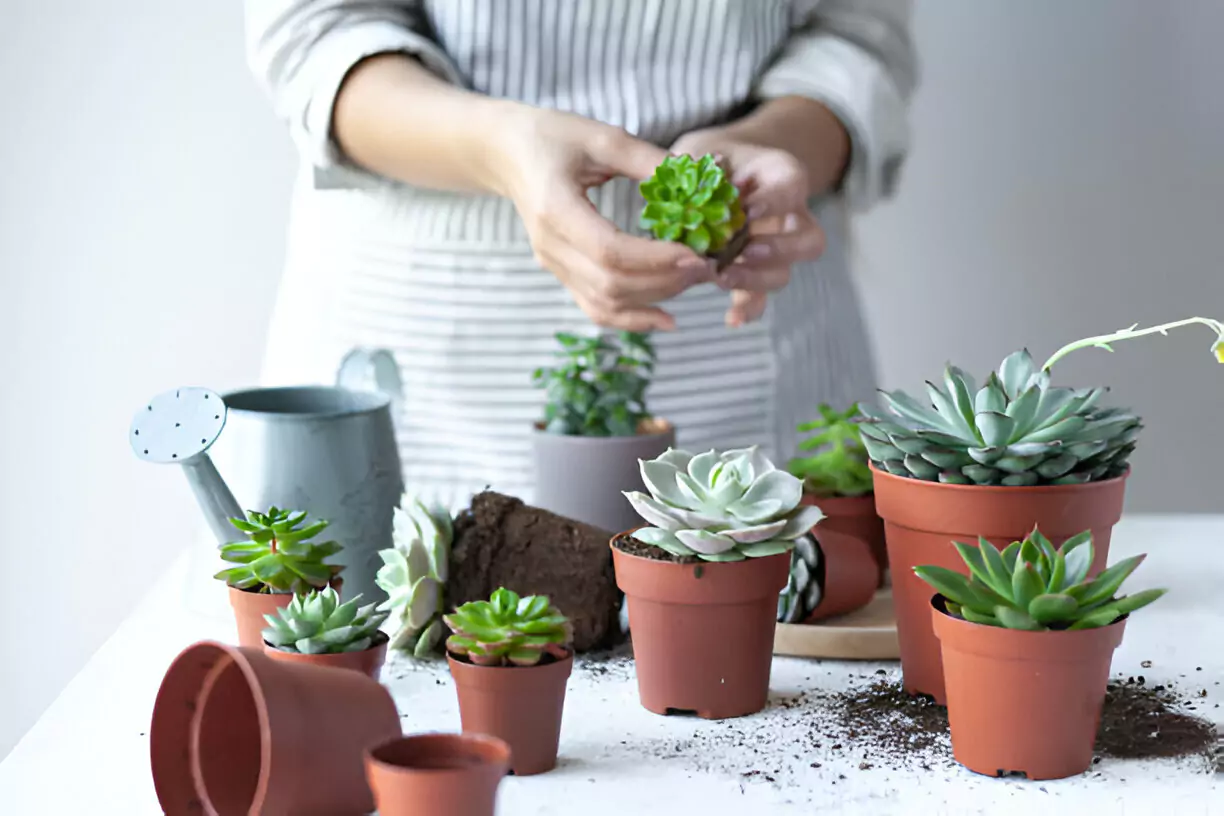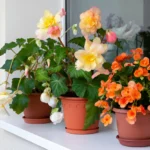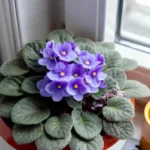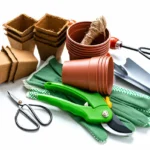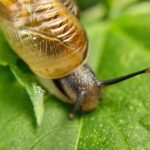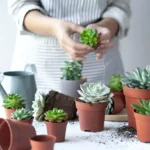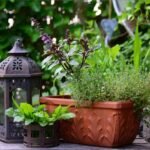Who does not like colourful succulents? I like succulents because of their shapes, colours, and leaves. There is a kind of white powder on their leaves that you can see if you put your finger on it. However, you will find succulents everywhere! Succulents are now used in all nurseries, gardeners’ homes, landscaping areas, restaurants, and shops. Succulents are popular as houseplants. They look great in the living room, on a desk, or even in your perfect kitchen. No problem if you don’t have room for large houseplants; you can grow these small succulents indoors. You have to learn how to care for them. However, beginners in succulent plant care tend to make mistakes, which can result in their favourite succulents being unwittingly killed or stunted and unhealthy even if they are still alive. I remember bringing home two succulents from the nursery about 2.5 years ago, but I didn’t even know how to care for them. Still, their colours captivated me, so I bought them.
However, I brought them in, left them as they were, and watered them when I felt like it! No matter what I did, the succulents eventually died from root rot. But now I have a total of 22 succulents, and they are much healthier and happier.
In this article, I’ll walk you through 12 mistakes you can make that won’t kill your succulents, with bonus tips at the end. Keep reading.
Succulent Plant Care Mistakes
1. Treating Succulents as Low-Light Plants
The biggest mistake that people make when growing succulents is not having enough light. Many gardeners, including novices, think that succulents will lose their leaves in the sun. Succulents come from South Africa, Mexico, and the United States (Arizona). They have adapted to severe drought conditions. They have adapted and developed under direct sun for an average of 8-14 hours.
So if we bring them home and do not give them enough light, the growth of the plant will stop and it will become leggy. You should keep the plant in a place that gets at least 6-10 hours of light. Many experts keep succulents near windows, and I have seen them use grow lights during the day as well. When asked about daytime lighting, I noticed that the succulents were not getting enough sunlight, causing their growth and leaf colour to fade.
Once they started to shine a low-range grow light near the succulent during the day, the succulent returned to its colour and growth within a few days. This means you can grow lights for succulents during the day if you can’t get enough light indoors. Succulents need to maintain the right temperature in your room. If you live in USDA zones 3-12, you can keep succulents indoors; check out our list below.
USDA Zone: 3-6 Cold-hardy succulents
USDA Zone: 7-9 Cold and frost-tolerant succulents: aloe, sedum, yucca, sempervivum
USDA zone: 9-11 Succulents that thrive in warm weather and light snow: kalanchoe, echeveria
USDA Zone: 10-12 Tropical succulents: jade plant, saguaro
Learn about succulents before you bring them home because weather and temperature play a huge role in growing succulents in your home.
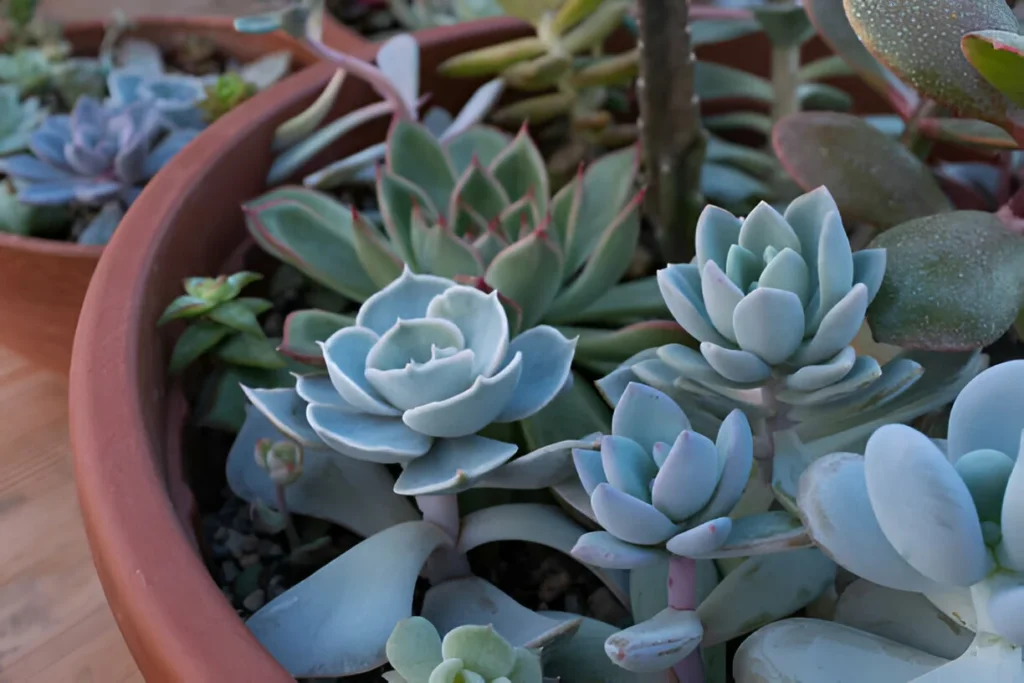
2. Pot That is Too Large
In nurseries I occasionally visit, I notice that succulents are misplaced in large pots. Such a pot will move to someone’s house, and they may not change the pot again. Once the root of the succulent roots, the plant will die. So where is the relationship between succulent pots and rotting roots? There is a relationship, let me tell you.
When you are planting a small or medium-sized succulent in a large pot, it means more medium, more water, and more moisture, which will eventually cause root rot. Succulents like their roots to be dense. Desert succulents grow their roots in desert stones, lava rock, and sand.
If you put them in a big pot, their roots will get excess water from the medium, and when you water, their roots will float in the water, causing the plant to rot slowly. Choosing the perfect-sized succulent pot for growing is very important to you. You should set pots 1/2 inch larger than the current size when reporting succulents, not 4/5/6 inch pots.
3. Not Practicing Pest Prevention
After keeping your succulent indoors, your plant can also die if you don’t check under their leaves and kill pests regularly. Succulents are commonly attacked by mealybugs, scales, aphids, and spider mites.
They roam and hide on the back side of succulent leaves. You may easily capture these pests if you turn the leaves and succulent container regularly. However, most of us are too lazy to apply pesticides to our plants regularly. When pests attack, our common sense awakens, and we jump in to control the insects. But if these insects attack the succulents in excess, the leaves will drop, and your succulents may need to recover quickly.
So I would highly recommend that you always check the plant. If it’s feasible, carefully remove the succulent media from the pot, examine the roots to determine if they’re damaged, clean the roots, and repot in a different container. You should spray your houseplants with neem oil at least twice a month, but it is better not to spray succulents.
If water accumulates on their leaves, rotting may occur. You can take the succulent in a bowl with a mixture of neem oil and water and wipe it with a cotton swab. As a result, the leaves will look cleaner, and insects will stay away.
4. Not Using Succulent Soil
After bringing succulents home from the nursery or online, remove them from the nursery pot and plant them in your succulent soil mix. Do not plant succulents in garden soil or regular potting soil.
Placing succulents in the wrong medium can cause growth and root rot problems. Succulents should be planted in a gritty medium. I make my medium by mixing bark, perlite, stone or lava rock, and worm compost.
When I plant succulents in this medium, water immediately collects in the saucer through the drainage holes when I pour it. Stone, bark, and perlite allow air movement in the medium, creating air pockets. The succulent plant’s roots grow well in a medium and spread over the pot.
When you put them in a potting mix or regular garden soil, the soil has fewer air pockets and remains wet due to a lack of good drainage, which results in root rot of the succulent. Succulent potting mix is available at big-box retailers and online. Before you buy potting mixes, look at the labels and check the quantities of each ingredient. It is best to buy every ingredient and make it yourself at home. You can provide well-draining soil for succulents on a budget.
Mold and bacteria grow in excess moisture. However, using a well-draining medium at home doesn’t risk mould or bacteria growth.
5. Watering Too Much
Succulent plants are called succulent plants because they can store water in their bodies and leaves. The tissues of succulents are filled with water, and when they suffer from water deficiency, their tissues deliver water to different parts of the body and roots. Most tropical plants can store water in their bodies. If you cut the leaves or stems of aloe, echeveria, gasteria, jade plant, burro’s tail, or string of pearls, you will see how juicy they are. However, if you give them too much water, they will rot in the medium and cause root rot. When watering the succulent’s medium, it is important to check whether your succulent is thirsty or needs water after a few days. A common mistake is to water succulents when we feel like it or when we have time. The result is the softening of the leaves of the succulent or the rotting of the root. How much water you can give indoor succulents depends on several factors: room temperature, weather, the type of succulent, the medium, and the season. During winter, you can water your succulents once every 3-5 weeks. There are some simple but effective rules for watering. Most growers don’t know why we kill succulents with excess water. Before we water the succulent, we should insert our finger 1 or 2 inches into the medium to see if the medium is moist or dry. However, using a moisture meter is the most effective technique to find the medium dry and moisture quality. Then, you can check the succulent pot by hand before watering. If it seems heavy, refrain from watering. Do not spray water on succulents. Use a long-nozzle watering can and take your time. Wait until the water comes out through the drainage hole. Stop watering the medium when the water comes out of the bottom. If you water the succulent in this way as a daily routine, you’ll notice that it receives less water after each watering.
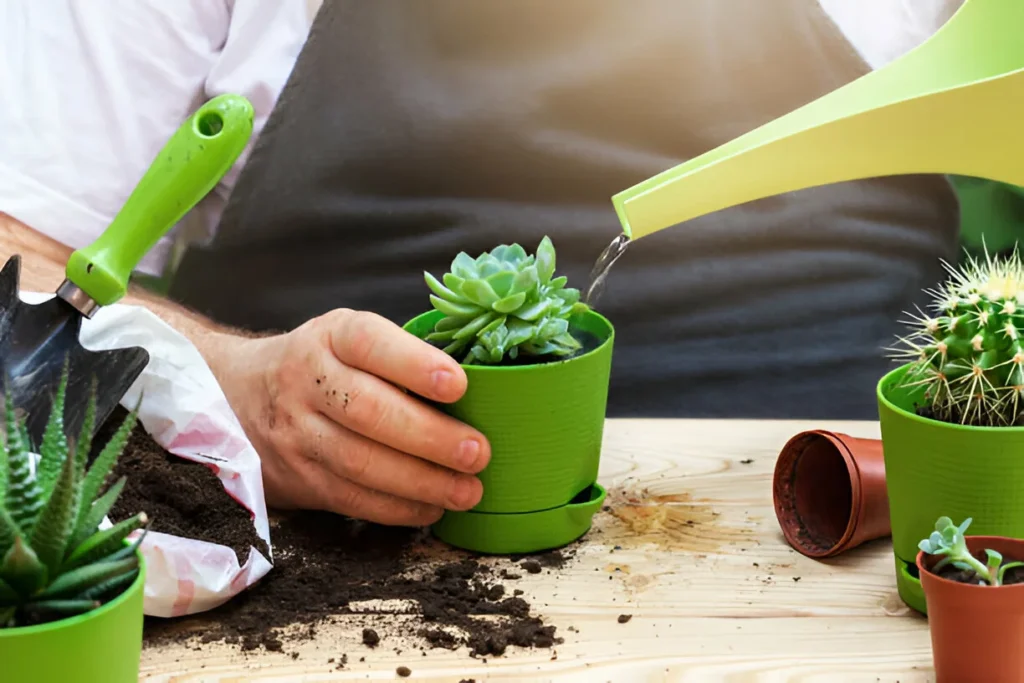
6. No Airflow Around the Plant
You can keep succulent plants near windows. This will ensure air circulation and greatly improve the growth of your succulent. Many people put their succulent plants in a closed room or an area of the house where there is no air circulation, and the plant looks unhappy.
Choose a location with light and air circulation to keep your succulent plant fresh and vibrant. You will see how beautiful and juicy your succulents will turn out.
7. Wrong Type of Pot
I know someone who put a succulent in a glass pot without a hole. I requested her to change the pot after noticing it. She was busy and lazy. After a few days, she sent me pictures of the plight of the succulent on WhatsApp, and eventually, the succulent rotted to death. If you also put succulents in the wrong pot, your plant can die. But if you are an expert or a pro gardener, it is a different matter.
But newcomers choose the wrong pot and sit curiously, and eventually, the succulent roots. The best results are obtained by planting succulents in clay or terracotta pots, and yes, of course, the pot should have at least one hole, preferably more.
If you want to put succulents in a decorative or ceramic pot, first plant the succulent in the nursery pot, then put the plant with the nursery pot inside the cover pot. Never plant succulents in pots without holes. Succulents placed in terracotta or clay pots have the ability to absorb water.
If you make the mistake of overwatering, the pot will absorb water from the medium, which is great for your succulents.
8. Leggy Succulent
Your succulent can become leggy if it is given too much light or too little water. They have a nasty habit of becoming tall and losing true shape when there is a variation in light or water. Whenever you see this, you should know that you have not given your succulent the environment and care it needs.
You should start to find out where the deficiencies are, and when you find them, try to correct them quickly. You can cut the leggy stems or leaves or transplant them.
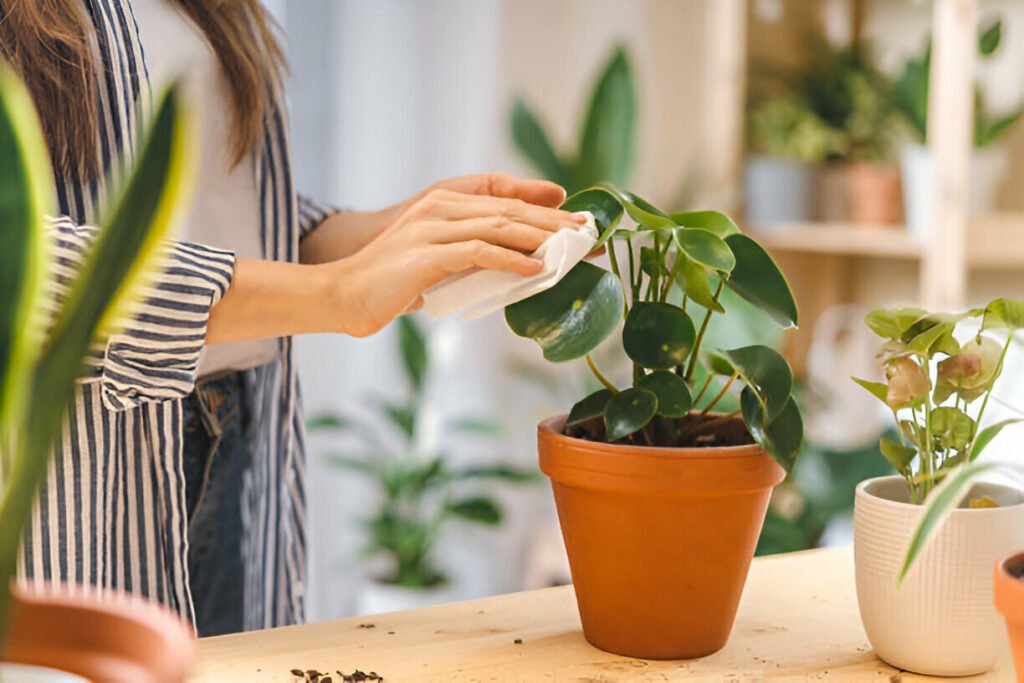
9. Cleaning Your Succulent Plant
If the leaves and stems of succulents are not cleaned, dust can accumulate, which inhibits photosynthesis and attracts dust mites. You should have a very soft small paintbrush. You should regularly clean the dust from the leaves of your succulent. This will make your succulent look more glossy and shiny.
10. Rocks in The Bottom
Glass pots, porcelain, and ceramic pots (without holes) often have a layer or substrate of stone on the bottom, which is not useful. As you water, the water sinks to the bottom of the pot by gravity and collects on your rocks before returning to the soil.
This will raise the possibility of rotting and keep your succulents in wet soil. If you plant the succulent directly in a pot with drainage holes rather than a layer of drainage slabs or stones, there is no risk of root rot.
11. Incorrect Fertilizer
Winter or dormant fertilization of succulents might lead to growth and health issues. You should fertilize the succulent during its active season. Fertilizing them when they are dormant means you are trying to wake them up, which can be a big mistake.
Yes, your fertilizing may appear to force the succulent to try to grow, but this can put them at health risk later on, and you should never do that. They should be fertilized from spring to summer during their active season. You can fertilize them with worm compost or a balanced fertilizer, depending on the size of their pot.
12. Remove Damaged Leaves or Twigs
You should regularly check and discard the dead, yellow, and dried leaves of the succulent. If you don’t discard the leaves, they can stick to the succulent and cause mould or bacterial infection.
Take the succulent pot and throw off the dead leaves on a regular basis when you water them. When you are repotting a succulent, you will see the dead or dried leaves sticking to the lower part of the plant. You should trim them before repotting.
Bonus Tips
Always choose a healthy one when you buy succulents. Check the medium and look at the back side of the succulent leaves. If you see pests, there is no need to bring that succulent home. If you open the leaves of succulents when you bring them home from the nursery or when you buy them online, there is nothing to be afraid of, and you can transplant them. Place the leaves in a well-draining medium, and they will become seedlings. Happy gardening!
Adding the above 12 rules to your succulent plant care routine regularly will reduce the risk of your succulent dying. Also, your succulent’s growth, colour, and shape will be perfect. I thank you for reading our post and for spending time with us.
